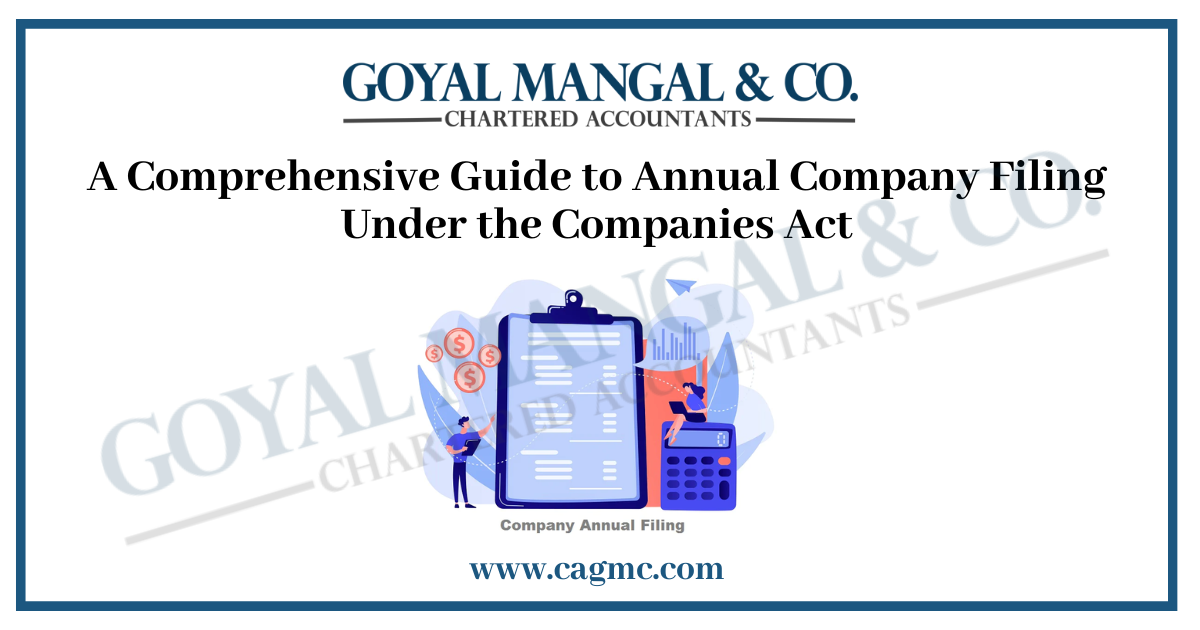
A key part of a company’s operational system is to make sure that regulatory rules and legal requirements are followed. According to the companies Act, 2013, companies registered in India must file accounts and returns every year. This complete article tries to give you a full understanding of Annual Company Filing under Companies Act, 2013 and the purposes they serve.
|
Table of Contents |
Overview
The companies need to submit their annual financial statement within 30 days and annual return within 60 days from the conclusion of AGM and also company’s annual compliance list. Annual Reports under Companies Act 2013 also need to be submitted. The Companies Act of 2013 stipulates the regulations for the submission of yearly financial statements to the Registrar of Companies (ROC), as outlined in Sections 129 (3) and 137.
The above sections are examined in accordance with Rule 12 of the Company (Accounts) Rules, 2014. Furthermore, it is important to note that the annual return is governed by Section 92 of the Companies Act, 2013, in conjunction with Rule 11 of the Companies (Management and Administration) Rules, 2014.
Types of Financial statement that companies require to prepare
Companies are obligated to formulate and present a set of five distinct financial statements:
- Balance Sheet: The balance sheet is a financial statement that provides an overview of a company’s financial condition, displaying its assets, liabilities, and shareholders’ equity.
- Income statement: The Income Statement, sometimes referred to as the profit and loss statement, offers a concise overview of a company’s generated revenues and incurred expenses over a specific timeframe.
- Cash Flow Statement: The funds Flow Statement are a financial statement that monitors the movement of funds into and out of an organization over a designated timeframe. This aids in comprehending the cash management practices employed by the organization, encompassing the sources and destinations of its cash flow.
- The Statement of Changes in Equity: It provides a comprehensive overview of the alterations that have occurred in the ownership structure of the organization within a given period. The analysis encompasses several aspects such as investments, profits, and losses.
- The notes to the financial statements: They serve as supplementary information that offers further evaluation and specificities to enhance the comprehension and interpretation of the accompanying financial statements.
The financial statements play a critical role in enabling investors, creditors, and other stakeholders to evaluate a company’s financial performance, make informed investment choices, and ascertain compliance with legal and accounting regulations.
Objective of Financial Statement and Annual Returns:
Certainly, here are the objectives of financial statements and Annual Company Filing Under the Companies Act, in simple terms:
- Transparency and Accountability: The primary purpose of financial statements and yearly returns is to present an accurate and transparent representation of a company’s financial well-being. The provision of transparency facilitates the comprehension of the company’s performance by stakeholders, including shareholders and creditors.
- Performance Evaluation: These reports help assess a company’s financial performance over time. Are they making a profit? Are they growing or struggling? This information is crucial for making investment and lending decisions.
- Legal Compliance: The Companies Act mandates that businesses maintain and submit these records. It ensures that companies follow the law and report their finances accurately.
- Taxation: Financial statements are used to calculate taxes owed by a company. Accurate financial information helps both the company and the government determine the correct tax amount.
- Creditworthiness: Lenders and creditors use these reports to decide whether to extend credit or provide loans. A healthy financial statement can improve a company’s chances of securing funds at favourable terms.
- Historical Record: These documents serve as a historical record of a company’s financial activities. They allow comparisons of financial performance over multiple years.
- Decision-Making: Company management relies on these reports to make informed decisions. It helps them allocate resources, plan, and set goals.
- Trust and Confidence: Maintaining and sharing financial statements and annual returns builds trust with investors, customers, and other stakeholders.
Financial statements and yearly returns play a crucial role in comprehending a company’s financial status, guaranteeing adherence to legal requirements, facilitating well-informed financial choices, and cultivating confidence among stakeholders.
Due dates for Company Annual Filings
Deadlines for the Annual Filing of a company:
- DIR 3 KYC Form: The DIR-3 KYC form is required to be submitted by any individual who has been assigned a Director Identification Number (DIN) and whose DIN status is ‘Approved’ at the end of the fiscal year. The deadline for the Financial Year falls on the 30th of September, of Assessment year.
- ADT-1 Form: The Form ADT-1, need to be submitted within 15 days following the end of annual general meeting. The Form ADT-1 is related to appointment of Auditor. For the financial year, the deadline for submission is set for the 15th of October of Assessment year.
- AOC 4 & AOC 4 CFS Form: The Form AOC-4 and Form AOC-4 CFS need to be submitted within a period of 30 days following the conclusion of the Annual General Meeting (AGM). The deadline for filing OPC is set at 180 days from the conclusion of the fiscal year. ROC filing due date for private limited companies may differ from OPC.
- MGT-7 & MGT-7A Form: The Form MGT-7 and Form MGT-7A, need to be submitted within a period of 60 days following the end of AGM. The form is related to filing of Annual Return.
Certification by company secretory
The certification of the Annual Return of the corporations mentioned below is required to be conducted by Practicing Company Secretaries (PCS) using Form MGT-8.
- Companies that are publicly traded on a stock exchange.
- Companies possessing a paid-up share capital amounting to ₹ 10 Crores or above.
- Enterprises exhibiting an annual revenue of ₹ 50 Crores or greater.
Please be advised that MGT 8 should be sent as an attachment to the yearly return Form MGT-7. The ultimate submission entails the completion of the Form MGT-9, which serves as an abridged version of the Annual Return.
More about Financial Statements and Annual Returns
In the case of a One Person Company (OPC), Small Company, or Start-up Private Company, the Company Secretary should endorse the annual return if there is one. If there’s no Company Secretary, the Director can sign it.
For other types of companies, both a Director and the Company Secretary must sign the annual return. If there’s no Company Secretary, a practicing company secretary can sign it.
Financial statements require clearance from the Board of Directors before being signed on the Board’s behalf. The Board’s chairperson, two directors (one of whom must be the managing director, if one exists), or the CEO, CFO, and Company Secretary, if nominated, can sign the financial statement.
Takeaway
In conclusion, following guidelines of the Annual Company Filing Under the Companies Act 2013 is essential for maintaining legal compliance and transparency. By submitting accurate and timely financial reports, businesses build trust with stakeholders and facilitate sound financial decision-making. These filings not only fulfil legal obligations but also help companies demonstrate their financial health, contributing to their overall credibility and reputation in the business world.







